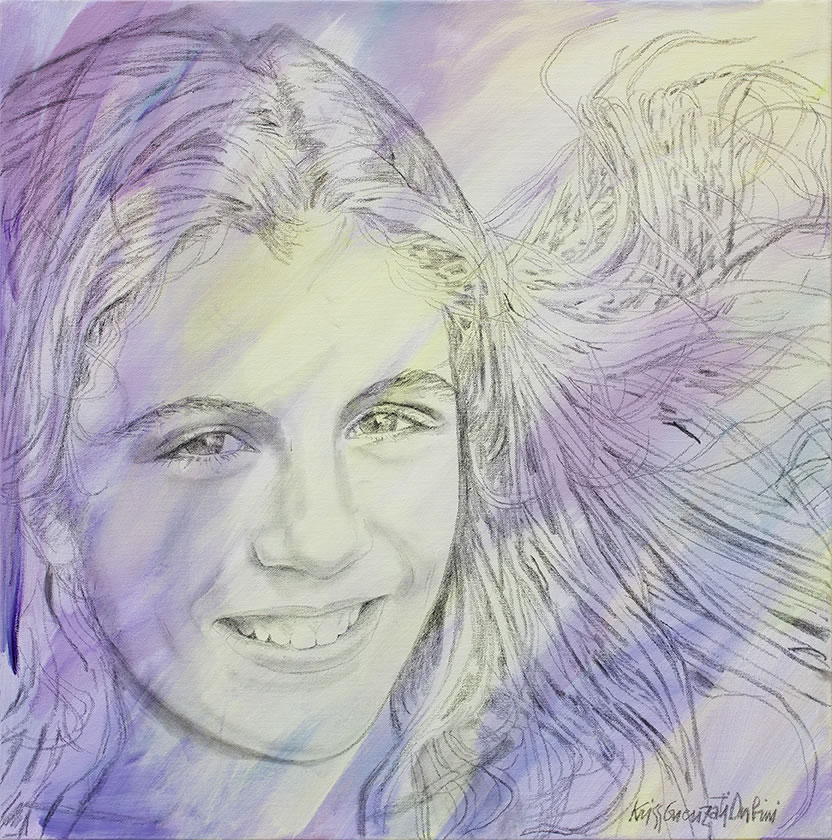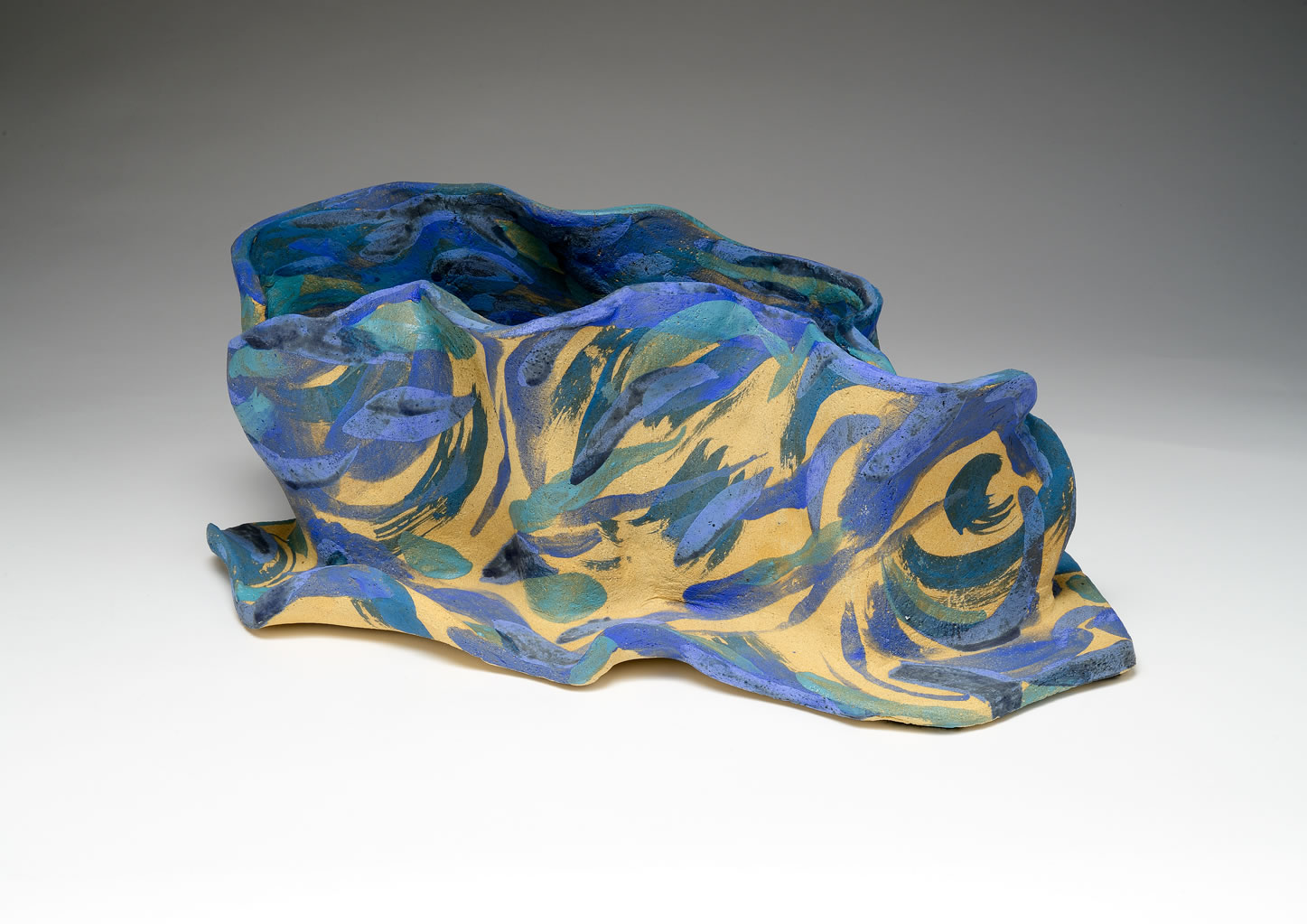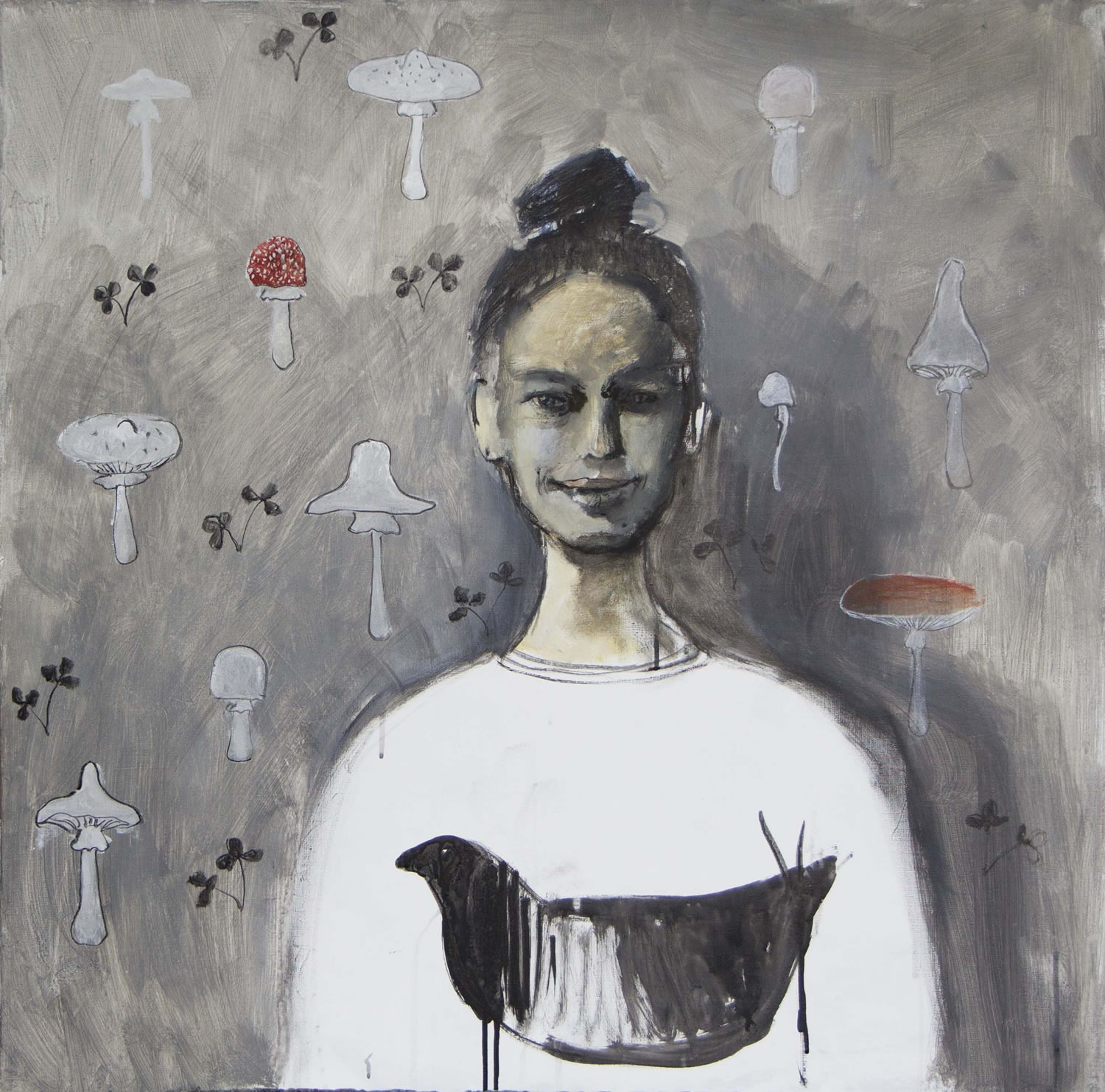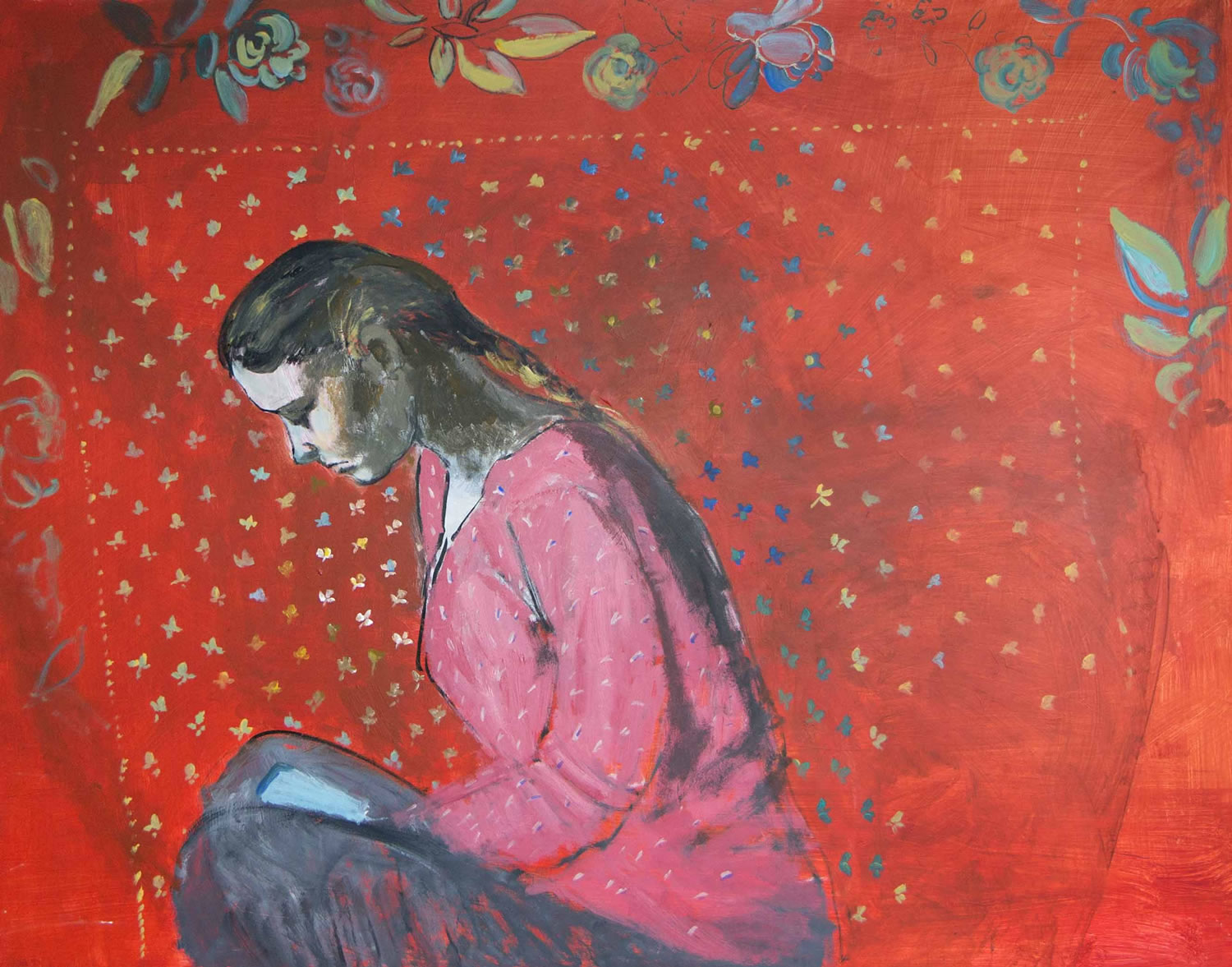The All-Russian Decorative Art Museum, the Italian Institute of Culture in Moscow and the East Meets West Gallery are proud to present a new international exhibit “Face to Face”, featuring Italian painter and sculptor Kriss Guentsati Dubini and Russian painter Ekaterina Rozhkova. The exhibition will run from March 4 through April 10, 2017 at the All- Russian Decorative Art Museum.
The exhibition symbolizes not only the meeting of these two artists, but also the meeting of values of two worlds and two cultures. Exploring the faces of their contemporaries, each artist focuses not only on the external and interiors state of the subjects themselves, but also on the symbols and attributes of their national, social and family life.

Kriss Guenzati Dubini, Francesca, 2014. Acrylic-charcoal on canvas, 80×80

Kriss Guenzati Dubini, Bust with Flower, 2002. Glaze on gres, 40x25xh65
Kriss Dubini’s portraits emphasize primarily the social status of her subjects and less so their human feelings. “Kriss Dubini uses perhaps the most interesting attributes in her refined coal portraits, which correlate with antique figures or parts of the Greek temples, creating a historical memory of the Renaissance history memory, thus proving that antiquity still feeds European culture today. Criss’ picturesque images of elite families often carry the hints of glamor of today’s Italian beau monde ….” (E. Schatz) Placed next to ancient sculptures and temples, her models rise to the level of heroes.
Her sculptures and ceramic objects are rather different; female torso lines are simpler and more lifelike, often without any affectation. Italian materials and techniques such as terracotta, mosaic and glaze lend themselves to the choice of simpler subjects without high social attributes or

Kriss Guenzati Dubini, Barcaccia, 2012. Engobbio on gres, 50х25хh22
symbols, making the works very contemporary.

Ekaterina Rozhkova, Katya Lebedeva, 2017. Mixed media on canvas, 80х80

Ekaterina Rozhkova, Student Sasha, 2017. Mixed media on canvas, 100х120
Ekaterina Rozhkova interprets the same theme in a different way. It’s not just the name of her new series of her works (“City of Women”) that seems symbolic, but also the way that she approaches the human portrait. All her female subjects are typically representative of our time; they live in Russia in the 21st century and are either her close friends or good acquaintances.
Her characters have a lot in common: a sense of respect to roots, to family traditions and to the past. “In this series I have tried to find a relationship between these women and traditional home furnishings and clothing. I attribute to each character a particular item of daily life; it may be a Russian calico shawl from Ivanovo, a wooden casing, a spinning wheel, maybe a red sarafan or a carved wooden box. This world of objects, whether painted or real, helps solve the puzzle of the Russian woman, her patience, her diligence, her integrity.” (E. Rozhkova).

Ekaterina Rozhkova. Artist Katya Taguti, 2017. Mixed media on canvas, 180х100
The Museum’s Fabrics Department displays superb examples of Russian women’s craftsmanship from the 19th and early 20th centuries: calico shawls, one manufactured by the Baranov factory, several festive female headgear pieces (Vologda, Olonetskaya and Tver provinces), and embroidered towels and valance from the northern provinces of Russia (Vologda and Arkhangelsk).
Wooden folk objects and utensils are presented by the Museum’s Wood and Bone Department, including a perfectly preserved carved wood window frame and frieze of a 19th century farm house (Volga region), salt shakers in the form of a cock and hen (Vologda) and other Russian 19th century utensils and household items that bear symbols of mythological motifs of the old Slavic pagan traditions.
A key element of Ekaterina’s earlier works was an object that loses its function and becomes a symbol of its time, status or age, and thus details like texture and color were relatively unimportant. For this reason, in her series “Mechanisms”, “Plates”, “Architecture” and others, she chose a pencil technique used by other artists mainly for sketches. But Ekaterina chose it as her main technique, giving her work a monochrome feel and allowing her to introduce elements of understatement and “hints” rather than a perfectly completed picture.
But now we have her portrait work, where she returns to a large-size canvas and to multicolored themes – as if she has already anticipated that the moment has come for a radical change. In her latest efforts she shows not only what it is like to look inward, into a fantasy world, but also to look in the eyes of another person.
Curator: Tatiana Paleeva
Press resease
East Meets West Gallery
“Face to Face”
The All-Russian Decorative Art Museum, the Italian Institute of Culture in Moscow and the East Meets West Gallery are proud to present a new international exhibit “Face to Face”, featuring Italian painter and sculptor Criss Guentsati Dubini and Russian painter Ekaterina Rozhkova. The exhibition will run from March 4 through April 10, 2017 at the All- Russian Decorative Art Museum.
The exhibition symbolizes not only the meeting of these two artists, but also the meeting of values of two worlds and two cultures. Exploring the faces of their contemporaries, each artist focuses not only on the external and interiors state of the subjects themselves, but also on the symbols and attributes of their national, social and family life.
Kriss Dubini’s portraits emphasize primarily the social status of her subjects and less so their human feelings. “Criss Dubini uses perhaps the most interesting attributes in her refined coal portraits, which correlate with antique figures or parts of the Greek temples, creating a historical memory of the Renaissance history memory, thus proving that antiquity still feeds European culture today. Criss’ picturesque images of elite families often carry the hints of glamor of today’s Italian beau monde ….” (E. Schatz) Placed next to ancient sculptures and temples, her models rise to the level of heroes.
Her sculptures and ceramic objects are rather different; female torso lines are simpler and more lifelike, often without any affectation. Italian materials and techniques such as terracotta, mosaic and glaze lend themselves to the choice of simpler subjects without high social attributes or symbols, making the works very contemporary.
Ekaterina Rozhkova interprets the same theme in a different way. It’s not just the name of her new series of her works (“City of Women”) that seems symbolic, but also the way that she approaches the human portrait. All her female subjects are typically representative of our time; they live in Russia in the 21st century and are either her close friends or good acquaintances.
Her characters have a lot in common: a sense of respect to roots, to family traditions and to the past. “In this series I have tried to find a relationship between these women and traditional home furnishings and clothing. I attribute to each character a particular item of daily life; it may be a Russian calico shawl from Ivanovo, a wooden casing, a spinning wheel, maybe a red sarafan or a carved wooden box. This world of objects, whether painted or real, helps solve the puzzle of the Russian woman, her patience, her diligence, her integrity.” (E. Rozhkova).
The Museum’s Fabrics Department displays superb examples of Russian women’s craftsmanship from the 19th and early 20th centuries: calico shawls, one manufactured by the Baranov factory, several festive female headgear pieces (Vologda, Olonetskaya and Tver provinces), and embroidered towels and valance from the northern provinces of Russia (Vologda and Arkhangelsk).
Wooden folk objects and utensils are presented by the Museum’s Wood and Bone Department, including a perfectly preserved carved wood window frame and frieze of a 19th century farm house (Volga region), salt shakers in the form of a cock and hen (Vologda) and other Russian 19th century utensils and household items that bear symbols of mythological motifs of the old Slavic pagan traditions.
A key element of Ekaterina’s earlier works was an object that loses its function and becomes a symbol of its time, status or age, and thus details like texture and color were relatively unimportant. For this reason, in her series “Mechanisms”, “Plates”, “Architecture” and others, she chose a pencil technique used by other artists mainly for sketches. But Ekaterina chose it as her main technique, giving her work a monochrome feel and allowing her to introduce elements of understatement and “hints” rather than a perfectly completed picture.
But now we have her portrait work, where she returns to a large-size canvas and to multicolored themes – as if she has already anticipated that the moment has come for a radical change. In her latest efforts she shows not only what it is like to look inward, into a fantasy world, but also to look in the eyes of another person.
Curator: Tatiana Paleeva
The All-Russian Decorative Art Museum, New White Hall, 2nd Floor
The exhibit runs from March 4 to April 10, 2017
The museum is open daily except Tuesdays, from 10:00 to 18:00 (21:00 on Thursdays)
Delegatskaya Str., 3
www.vmdpni.ru
+7 (499) 973 32 19
Watch us on Facebook.com and vk.com
East Meets West Gallery
Director Tatiana Paleeva
Tel.: 8 (916) 680 53 90
E-mail: paleeva@emwgallery.com
www.eastmeetswestgallery.com

